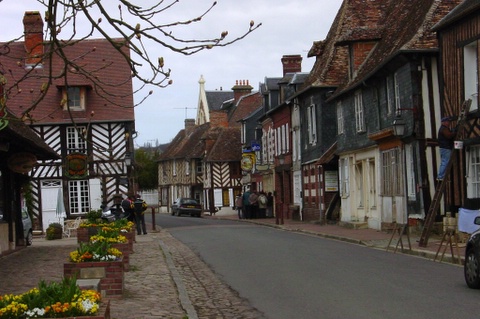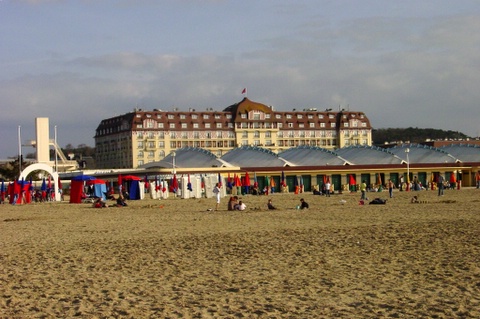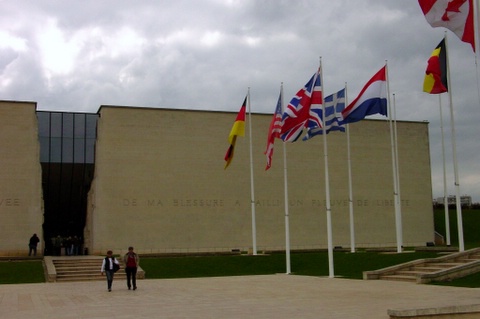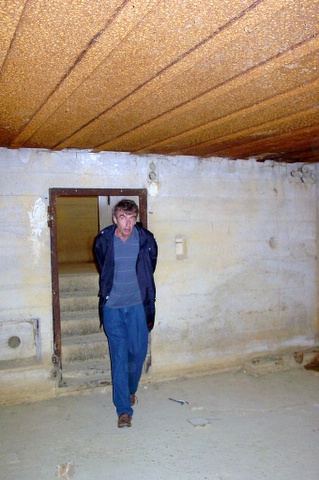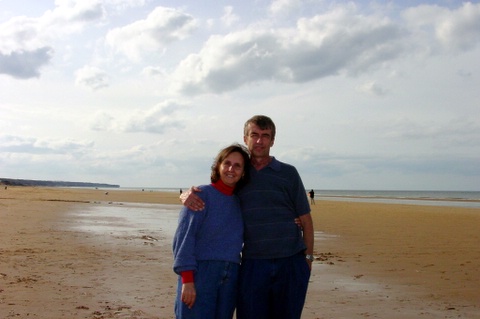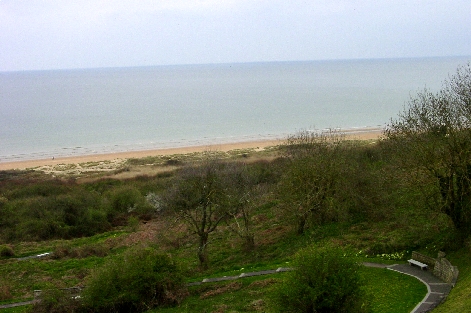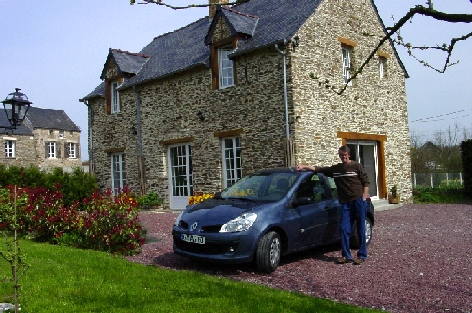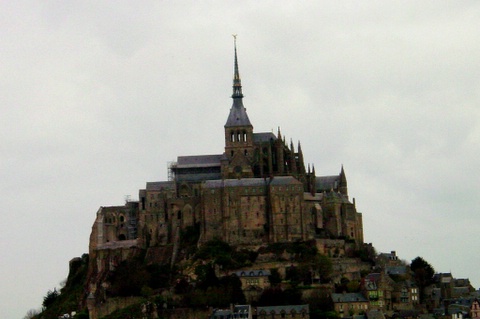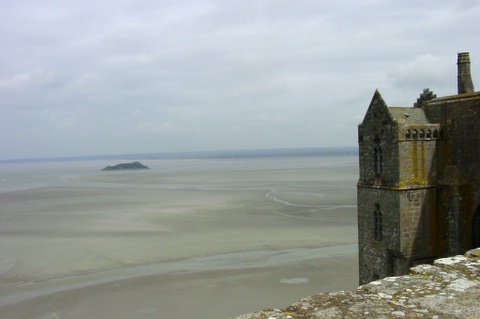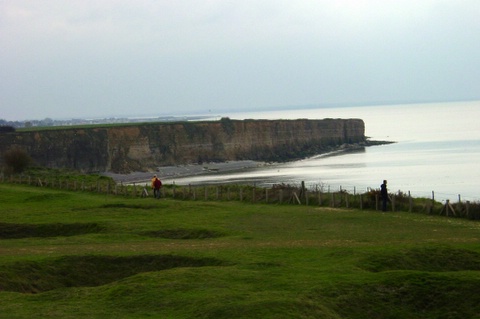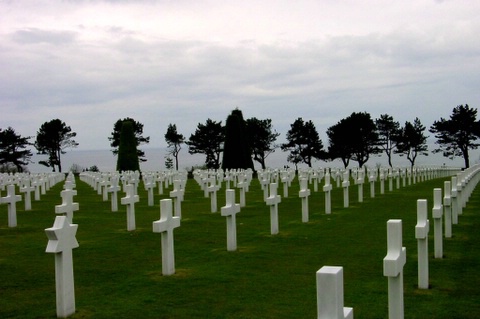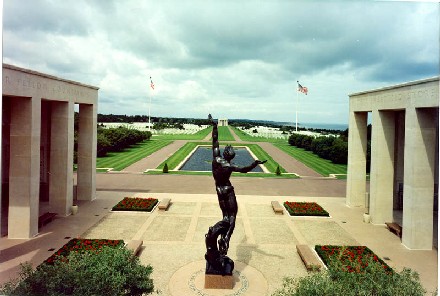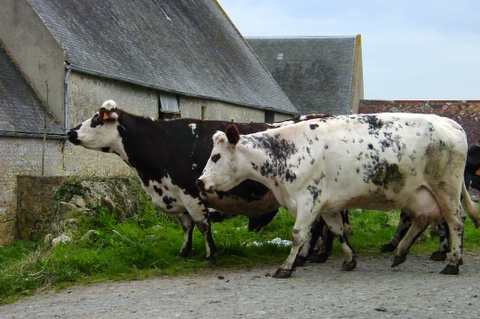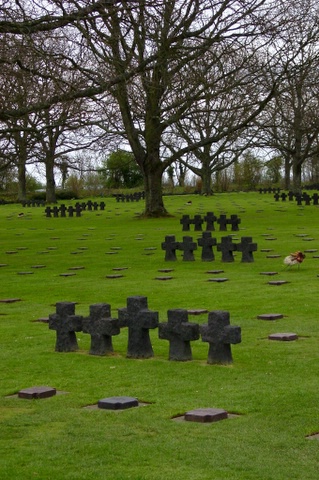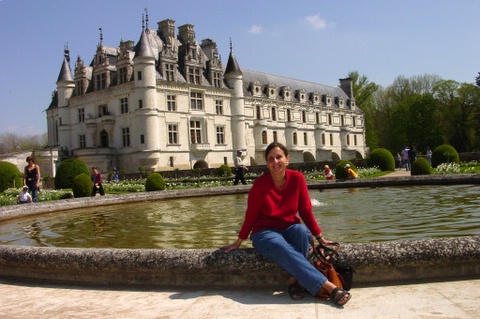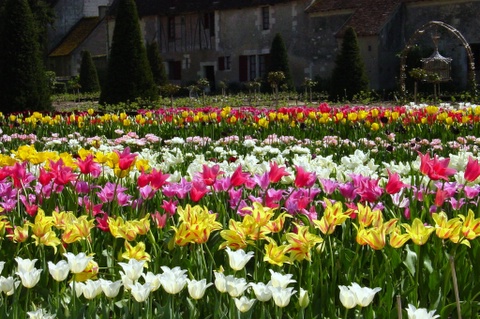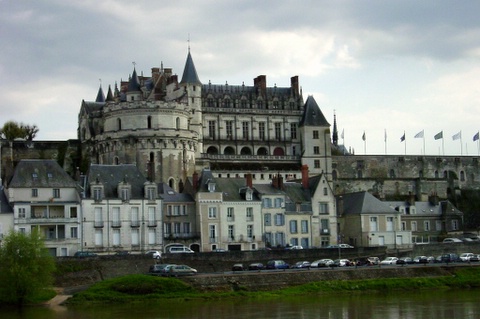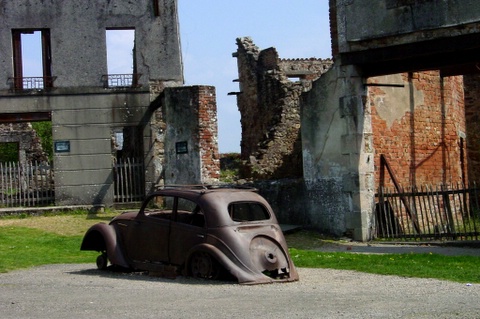|
|
|
|
East Normandy (April 17 & 18): We checked into our hotel in Honfleur -- the Mercure, right on the waterfront -- at dusk and realized the wayward luggage was going to be more of a pain than we had expected. A cold wind was blowing in from the English Channel, and all we had were the summer clothes we had worn from home, where it had been 30 degrees warmer. We decided to venture outside anyway, so I donned a red wool blanket as a shawl and we headed to the harbor area. As Mike said, "Everyone will be wearing those now".
We had a nice dinner (bouillabaisse, the local specialty) at l'Absinthe restaurant. It seemed pricey at the time -- about 70 euros ($84) for two dinners with wine and cheese -- but we hadn't seen anything yet.
The next morning, we bought two coats, exchanged money and enjoyed a walk around the gardens and harbor in Honfleur, a village that was a favorite of the Impressionist painters. In the afternoon, we took a long drive through the Pays d'Auge countryside, where cheese and apples are a virtual religion. We tried the apple cider and calvados, a very strong apple liqueur, in a big stone barn on one of the many farms that offer degustations (tastings).
The prettiest little town was the half-timbered Beuvron en Auge, which has one street, two churches and three pastry/coffee shops. It bills itself as "one of the most beautiful villages in France". We were going to be seeing a lot more of those.
|
|
|
|
On the way back to Honfleur, we stopped for a walk on the beach at Deauville, a glamorous seaside resort once known as a haunt of the rich and famous. "A Man and a Woman" was filmed here.
West Normandy & D-Day (Le Jour J) sites (April 19 & 20): Our luggage finally arrived this morning and we drove to Caen to the Musee de Memorial, a "peace" museum that chronicles the history of war in the 20th century. The main focus is on the buildup to WWII. The most powerful exhibit was a riveting, split-screen film showing the simultaneous unfolding of D-Day events on both the German and Allied sides.
|
|
|
From Caen, we went on to Arromanches les Bains on Gold Beach, where the British landed on D-Day. It was the site of an artificial harbor called Port Winston (Churchill), which was used to offload cargo after the Allied invasion. Old battleships were sunk to create a breakwater, and those who know about such things say it was one of the greatest engineering feats of the War. Sections of the pier pontoons and concrete caissons still remain on the beach and in the ocean.
We drove west to an old German battery at Longues sur Mer, where the original bunkers and even the guns are preserved. We had a picnic of sandwiches and apple cider and explored the bunkers and the pretty beach below.
|
|
|
The final stop of the day was Omaha Beach. It's absolutely pristine, with no souvenir shops, no signs, not even a (shock!) payant sign in the gravel parking area. In fact, it was fairly hard to find -- the drive to it was on narrow, twisting roads with very few signs. It's difficult to describe the feeling of standing on that peaceful beach and thinking about what happened right there more than 60 years ago. I could almost see the ghosts, and found myself feeling a little guilty for enjoying such a beautiful day here.
|
|
|
|
The area south of the beaches is "bocage country", where every town is named after a shrub, a saint or a river -- or sometimes all three. Our home for the next two nights was outside Villers Bocage at La Ferme du Pressoir, a farm bed-and-breakfast run by a delightful lady named Odile. We stayed in a stone sheep barn that had been converted into a six-room cottage. In the mornings, we walked downstairs and there was Odile in the kitchen, preparing our breakfast and offering sightseeing tips in kilometer-a-minute French.
We were getting by okay on my high-school French, but Odile and everyone else seemed to talk as fast as the guy in the old FedEx commercial, so I was frequently lost. The French are an ultra-polite people who use merci, s'il vous plait and madame/monsieur in just about every sentence, and they're very patient if you liberally insert those phrases into otherwise bad grammar.
My lack of fluency actually paid off late one night in Villers Bocage when our car was stopped by two local gendarmes. They claimed we had run the town's only (and almost invisible) stoplight -- a flashlight-sized beam mounted about three feet off the ground. The older cop gave us a lecture about how in France, le feu rouge means arrete, then told us the fine was 90 euros, payable right now. This was an obvious shakedown, as he didn't write out a ticket and he told us to deposit the fine in his personal wallet. I understood most of what he was saying, but kept repeating -- in very poor French -- "We're just stupid tourists", "We thought the light was yellow", and "I don't understand." He kept repeating "Quatre-vingt-dix euros!" while pointing to my purse and his wallet and rolling his eyes. I was on about the tenth Je ne comprends pas and was just about to try the "Take us to the station to pay" tactic when his younger partner whistled for him to join him across the street. He had flagged down an easier target -- a van with a driver who probably spoke French -- so we had become a bad investment of the cop's time. He threw up his hands in frustration and told us to aller out of there. I really wanted his photo, but decided not to press my luck.
That small disaster averted, the next morning we drove to Le Mont St. Michel, France's top tourist attraction. I had seen photos, but viewing the real thing was a jaw-dropper -- a village and an ancient Benedictine abbey on a giant crag, rising from a vast tide pool in the English Channel. The tide comes in as fast as a galloping horse, so they say, and tourists have drowned trying to outrun it. If the tide doesn't get you, the steps will -- we climbed hundreds of them to tour the abbey.
|
|
|
|
We returned to the Normandy beaches to Pointe du Hoc, a promontory that was taken on D-Day through the incredible bravery of U.S. Rangers. Three battalions landed here at 7:00 a.m. and scaled the 100-foot cliffs on a mission to eliminate a powerful German gun battery. Only half survived the machine-gun fire and made it to the top of the plateau. The 30-acre site still has the bunkers and bomb craters -- some more than 10 feet deep -- that remained when the Rangers left on June 8, 1944.
Late in the afternoon, we drove to Colleville-sur Mer to the American Cemetery. It's a beautiful, almost mystical, setting on a cliff overlooking the sector of Omaha Beach where the 1st Division landed on D-Day. It was impossible to hold back tears while walking among the 9387 graves there -- reading the names and hometowns and imagining their stories, finding pairs of brothers buried side by side, seeing the flowers placed on random graves by French volunteers.
|
|
|
|
We took country roads to the La Cambe German Cemetery, where more than 22,000 German soldiers are buried. In stark contrast to the American Cemetery's bright white crosses and Stars of David, the German graves are marked by black stone crosses, set low in the ground in groups of five. In many ways, this was the saddest sight of all. The atmosphere was somber and eerie, made more so by the fact that it was twilight and we were the only visitors.
We ended the day in Bayeux with a short stop at the cathedral and dinner at Le Pommier (The Apple Tree). We returned to the Villers Bocage farm very late, partly from confusion about what village we were going to (several other towns in the area have the words "Villers" and "Bocage in their names). The main delay was caused by our decision to take backroads around the town instead of through it so we could avoid the stoplight concession.
Loire valley (April 21-23): It took us most of the day to drive south to our next stop. We began with a "short" shopping errand to buy an electricity converter to charge my camera battery. It wasn't easy -- we visited at least a half-dozen "Brico" (hardware) stores before we found one, but we enjoyed the mini-tours of the four towns where we stopped. We finally arrived in the tiny town of Chenonceaux for a three-night stay at Hotel La Rosaraie.
|
|
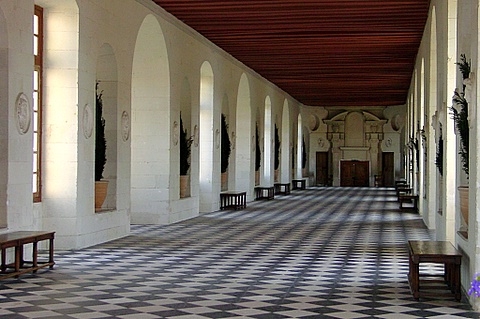 Chateau ballroom built over the river |
|
The next morning, we toured the Chenonceau chateau, a fabulously ostentatious castle built in the 1500s over the River Cher. Its historical significance is as the object of a famous French catfight between King Henri II's wife and his mistress, to whom he had given the chateau. After the king died, the widow banished the mistress to a "shabbier" chateau upriver, then spent a fortune redecorating.
We had a somewhat adventurous dinner at our hotel that evening. Mike decided to try the chef's specialty, which was "cheek of pork" (a fancy name for hog jowls), and I had a salad with hot chicken gizzards. Both were very edible, but we didn't ask for the recipes.
|
|
|
|
We spent the next day in Amboise, a pretty town on the Loire with an old royal palace and fortress. We toured Le Clos Luce, Leonardo daVinci's last home, which has been transformed into a museum of his work. It's surrounded by acres of gardens with full-size reconstructions of his inventions, including a tank and a helicopter.
Loire to Dordogne (April 24): We broke up the long drive south with a stop at the "Martyr Village" of Oradour sur Glane. Four days after D-Day, the Germans destroyed the town and massacred the entire population of 642 for no apparent reason. The village has been preserved just as it was that day, with signs added to the burned-out buildings showing the names and occupations of the shopkeepers.
To Page 2 -- The Dordogne & Languedoc-Roussillon
To Page 3 -- Provence & final ramblings


